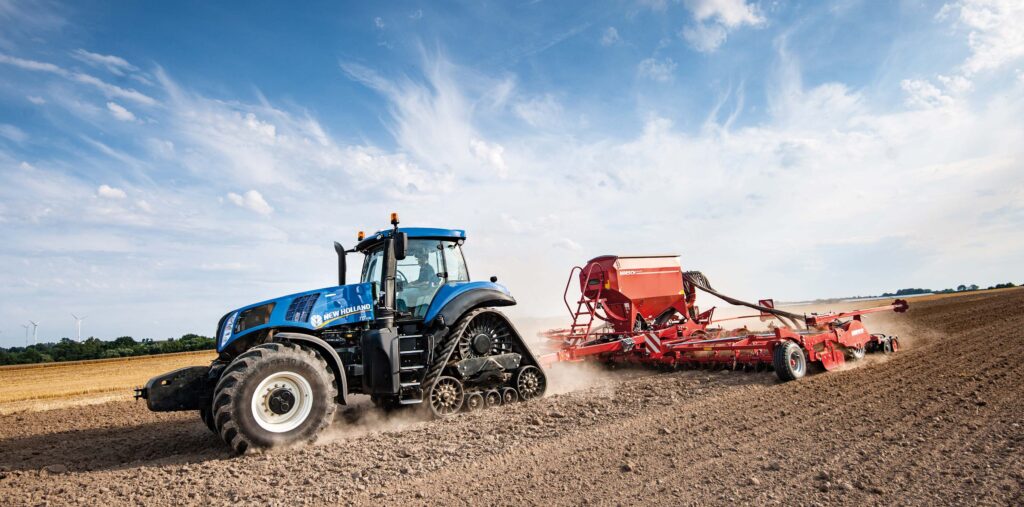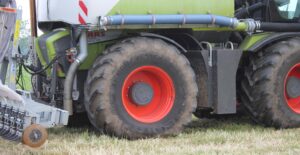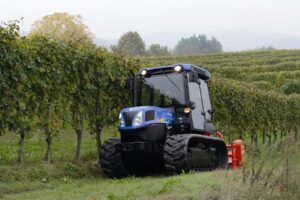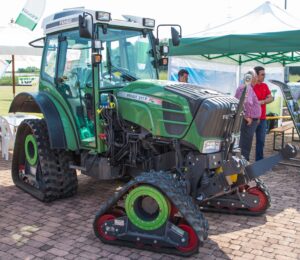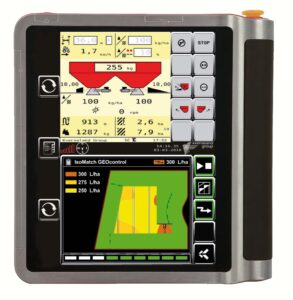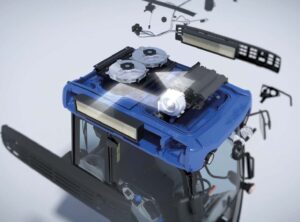The components of agricultural vehicles are now highly technological and the object of continuous research and development. Let’s see some news about it
by Davide Giordano
The components industry is a typical “business to business” sector, that is, relationships between component manufacturers on the one hand, and final vehicles on the other. A wide range of products is available, able to meet the needs of all industries. From complete transmissions to ready-to-install engine units, from tires to cabs, from braking devices to electronic control units: tractor and equipment manufacturers can look for the best available on the market to use it within their products.
In fact, the use of parts available on the market allows the manufacturer to optimize production costs, as the component manufacturer optimizes production costs thanks to economies of scale higher than the manufacturer of the final product. To this is usually added greater attention and innovation of the component, given the extreme specialization in that sector of the manufacturer. These are fundamental issues especially for the small and medium-size industries active in the agricultural sector; a production team particularly important for Italy and for the export of its products. Let’s see some examples together…
Tires…but not only
It is certainly one of the most important components in both tractors and towed implements. In fact, it allows the mass of the machine to be unloaded to the ground, ensuring that tractors also have the necessary pulling force to move and perform the required work. All this reduces soil compaction as much as possible, lasting several thousand hours of work and consuming as little as possible on asphalt. Characteristics that are difficult to manage, and for this reason tire manufacturers work a lot in research and development. In the last few years in the agricultural sector, innovations in this field are mainly related to a greater resistance and flexibility of the carcass, with the so-called VF (Very High Flexion) and IF (Improved Flexion) tires. These tires are able to work, with the same applied load, with lower inflation pressures. This increases the footprint on the ground, thus reducing compaction and improving traction. Having appeared on the market for a few decades now, they have, however, been used massively only in recent years, thanks to the reduction of costs and greater attention to the soil by farmers. The IF and VF technologies have also been extended to the tires of other machines, such as combine harvesters, sprayers and trailers.
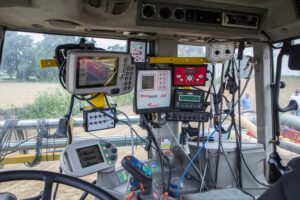
Without the ISOBUS and with different equipment to check, the risk is to have too many monitors and cables in the cabin
The only possible alternative to tires is the use of tracks, which in recent years has seen a considerable spread of the rubber variant. This is the main solution for earthmoving machinery, but a typically Mediterranean niche market still exists where the tracked agricultural tractor maintains a strong appeal. These are, in fact, machines with a very low center of gravity, with high grip and good transverse stability, therefore suitable for the most inaccessible areas, where tractors with tires would not be able to operate with sufficient stability.
The steel track is composed of an endless articulated chain, leading to the outside of the support pads. The chain forms a kind of rail, where the track carriage slides (formed by the driving wheel, the return wheel and the supporting rollers). The driving wheel, which is in fact a large gear, moves the track by inserting the teeth into its links. The idler wheel has the function to guide the movement of the track, also maintaining the right tension. The load-bearing rollers, on the other hand, are designed to support the weight of the tractor and to “unload” it properly on the ground. Obviously, the useful life of a track (with proper maintenance) can be up to twice as long as that of a tire, and the grip is significantly higher. Moreover, the legal maximum speed of tracked agricultural vehicles is limited to 15 km/h, and to travel on public roads it is necessary to apply thick stands in order not to damage the paving.
The rubber tracks have the same conformation as the steel ones, but the articulated chain consists of a sturdy belt (rubber) equipped with ribs, which ideally should add up the positive characteristics of the tire and the steel track. In any case, a steel core is inserted even in the rubber track, consisting of several endless bands of cables, drowned in the structural part, which gives it an appropriate strength, but also the necessary elasticity. In the inner part of the track is inserted a steel core, covered with rubber, which guides the sliding of the track on the teeth of the drive wheel. The part in contact with the ground is equipped with grip pads, often very similar to the ribs of drive wheel tires. The main advantages of rubber tracks relate to greater mobility than steel counterparts and to superior driving comfort. Relatively simple solutions are available on the market, which provide for the replacement of the steel track with a rubber belt, keeping the structure of the track carriage unchanged.
The considerable structural differences between the wheeled tractor and the tracked tractor have in fact prevented an interchange of propulsion components on the same machine. Recently, on the other hand, an alternative solution has been used on both tractors and self-propelled machines (combine harvesters in the first place), in which the wheels of an axles or both are replaced with independent tracks, with rubber belt and triangular or trapezoidal carriage, allowing to enjoy at the same time some advantages of both the track and the tyre. In detail, the supporting surface is significantly increased, thus optimizing grip and reducing soil compaction. Furthermore, when steering, if compared to traditional tracked vehicles, the topsoil is less damaged. In fact, unlike traditional crawler tracks, where one of the tracks is braked to steer (thus exploiting their different peripheral speed), independent tracks behave like tires, being mounted on vehicles with steering axle (or articulated in the case of small vineyard tractors). These tracks are built in a rather varied way: the number and position of the support rollers or idle rollers can vary; they can be equipped with nitrogen, oil or grease idlers and finally they can also be completed with hydropneumatic suspension devices, which considerably reduce the vibrations transmitted to the machine structure. In the case of after-market assembly, manufacturers usually adapt the connecting flanges so that the tracks can be mounted directly on the final gearboxes. Rubber belts are also different from each other, to adapt to widths, lengths and other special requirements. As with the rubber belts of traditional tracks, the most technically critical aspects are the duration of the tread and of the internal guides clinging to the drive wheel.
Electronics 4.0 with ISO-Bus
Until some time ago, the development of precision agriculture technologies was severely hampered mainly by the difficulties of communication between the electronic part of the tractor and that of advanced operating machines, such as variable rate fertilizer spreaders or sprayers with automatic section control and variable rate.
The two machines had to necessarily “dialogue” by means of interfaces (and connections) made for the occasion, often not sufficiently tested and reliable. In addition, the cockpit inevitably filled with monitors, cables and connectors, with all the annoyances and problems of the case.
In this sense, one of the first steps forward was the development of the Controller Area Network (CAN BUS, standardized by the SAE J1939 regulation), in the mid 80s of the last century. Thanks to CAN BUS, with a single connection all the electronic devices installed on a specific vehicle were able to communicate with each other: engine control unit, transmission control unit, etc., thanks to this single connection they are able to dialogue and interact with each other. It was a big step forward, especially in the automotive sector.
Despite its validity, however, the CAN-BUS was not sufficient to solve the other great problem that arose in agricultural mechanization, namely the communication between the tractor and the equipment, due to the incompatibility of the “proprietary” electronic systems existing at the time, unable to provide information in a standardized way, with the result that both the tractor and the equipment were equipped with their own terminals. To unblock the situation, through ISO (International Standard Organization) in the early 90s the ISO 11783 standard was born, most commonly referred to as ISOBUS, a system that could be adopted as an open communication channel between tractor and equipment.
The ISOBUS standard defines how the connections between the different control units (ECUs, Electronic Control Units) must be made so that there is compatibility between all the parts. The basic principle is very simple: the tractor is equipped with a Virtual Terminal (VT), which, with a single BUS, is able to communicate with all the connected compatible implements. At each restart, the tractor control unit and the connected devices check if there have been any change, configuring them accordingly; the Virtual Terminal shows the information coming from the ECUs of the connected implements and, depending on the ISOBUS implementation class, allows only monitoring or even control.
One of the first applications of this standard was high precision automatic guidance, where the onboard terminal of the tractor can also operate as terminal for the GPS device, so as to operate with high precision in all conditions, avoiding the double monitor. Not only that, now from the terminal you can interact with all the ISOBUS equipment: for example, the dosage of pneumatic seed drills can now be managed in a site-specific way, to prevent overlapping. ISOBUS-compliant sprayers are able to show the operator a complete overview of the operating conditions: forward speed, flow rates and working pressures, working autonomy in relation to the residual content in the tank. By accessing the Virtual Terminal the operator can manage the opening and closing of the sections both manually and automatically, thanks to the presence of georeferenced data from the GPS.
High protection cabins
On tractors and self-propelled operators, the driver’s seat has undergone a truly epochal evolution over the last 30 years, thanks to the assembly of technically advanced cockpits. In addition to the safety aspects (ROPS and FOPS) and the purely ergonomic ones (noise, vibrations, arrangement and operation of the controls, visibility, etc.), undoubtedly a feature of absolute importance concerns the maintenance of a healthy microclimate, not only from the point of view of thermal comfort, but also (and above all) with regard to the healthiness of the air.
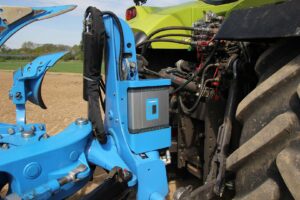
The ISOBUS is not only the prerogative of the most complex equipment, but can also be profitably used for the management of a plow
In fact, in the agricultural field there are many and various threats, both organic (e.g. gaseous emissions from livestock manure) and inorganic, such as dust deriving from the granulates of synthetic fertilizers and especially plant protection products. The latter, in particular, represent a well known, serious and very often culpably underestimated danger, due to its consequences (sometimes even lethal) that are subtly expressed over time, and that are shown in symptoms that can only be identified when in most of the cases it is too late to correct. In this sense, prevention plays a key role: in short, it is necessary to avoid coming into contact with the active ingredient of the pesticide because, contrary to what is commonly thought, by far the most dangerous mode of absorption is neither inhalation nor ingestion, but epidermal exposure. In addition to personal protective equipment (masks and helmets with respirator equipped with filters, overalls, gloves, overshoes, etc.) the most modern and practical solution is undoubtedly to equip the cabin with the machine (tractor or self-propelled operator) intended to carry out the treatments of an activated carbon filtration system, able to block the entry of dangerous substances.
Since the cabin is not, nor could reasonably be, watertight, it is also necessary to create a slight pressurization inside it, in order to be sure that the only air entering the cabin is the one previously filtered, and not that of the surrounding external environment, polluted by the pesticide at the time of its distribution. Technical progress has long provided adequate answers to this need, and several models of specialized tractors (for vineyards and orchards), as well as all self-propelled sprayers for both herbaceous and tree crops, have the possibility of pressurization and especially to mount activated carbon filters. The issue is of general importance, so much so that a few years ago it was the subject of the enactment of the European standard EN15695-1 and -2, which defines a classification of the cabin and its filters through laboratory tests, in relation to the level of protection provided. The current top is the so-called “class 4”, which ensures effective protection not only against dust, but also against aerosols and vapors (i.e. the most widely used forms of dispersion for the application of plant protection products).
In this specific case, it is therefore necessary that not only the filter itself is suitable, but also that its housing and installation methods are such as to ensure that the polluted external air passes only through the cartridge and not around it. This is a delicate aspect, generally the subject of little attention, even considering that the activated carbon filters are not eternal, but they need to be changed periodically. The replacement operation must therefore be carried out with the utmost precision, in order to maintain adequate sealing conditions. It would therefore be desirable that simplified but effective solutions for the execution of this maintenance work, are found at a constructive level.
Another delicate issue concerns the replacement intervals, which should logically be variable in relation to the functions of the cartridge (depending on the intensity of filtration and its natural aging process). Also from this point of view, it would be desirable that univocal filter exhaustion warning systems were activated, in order to proceed without delay and uncertainty to the replacement.

